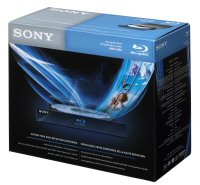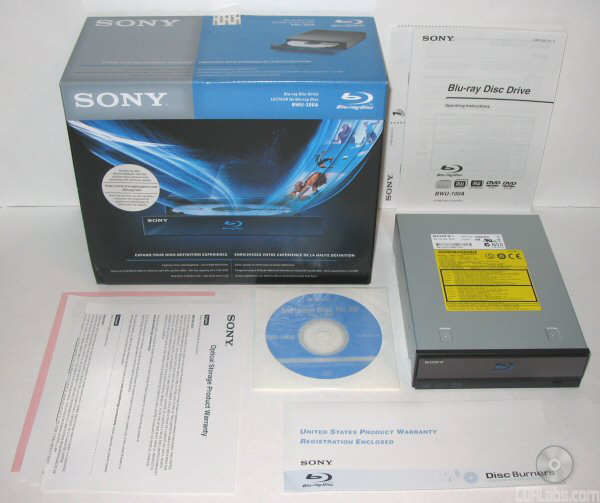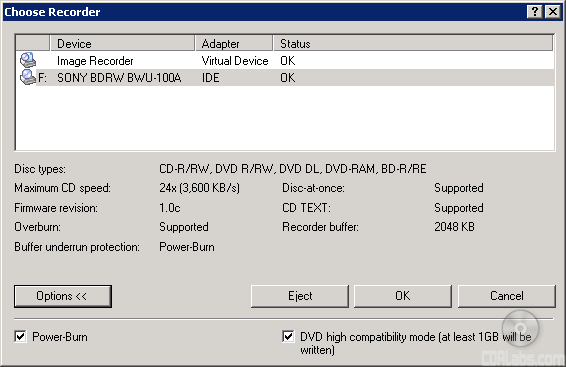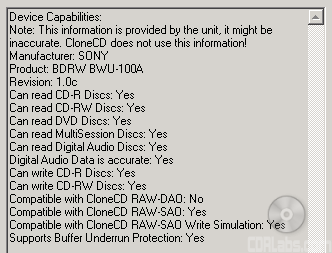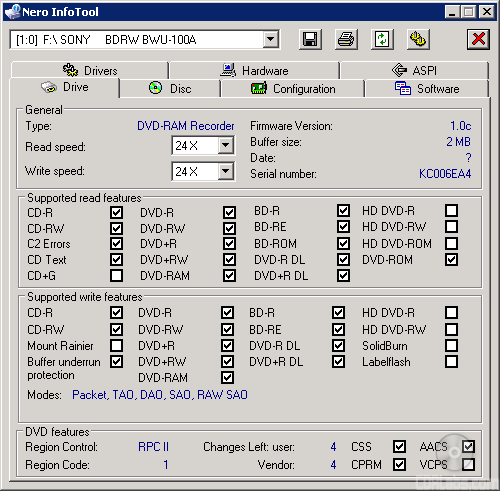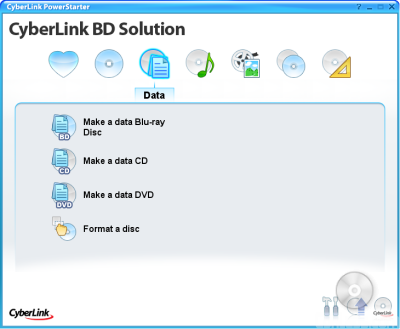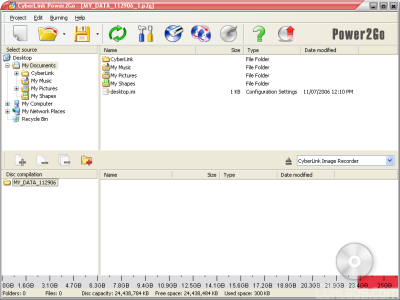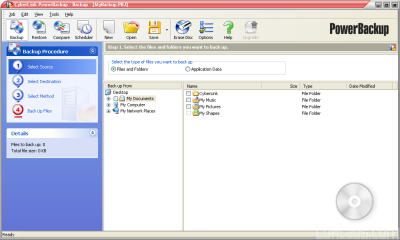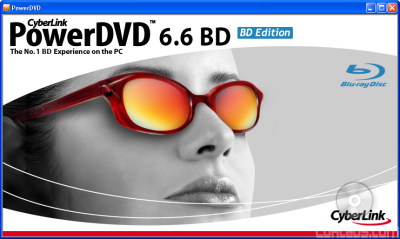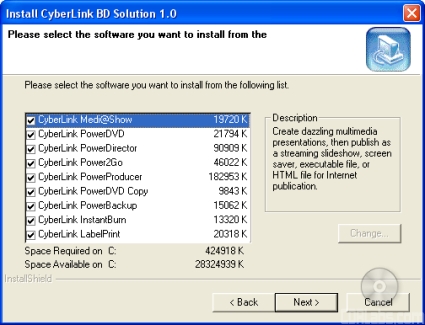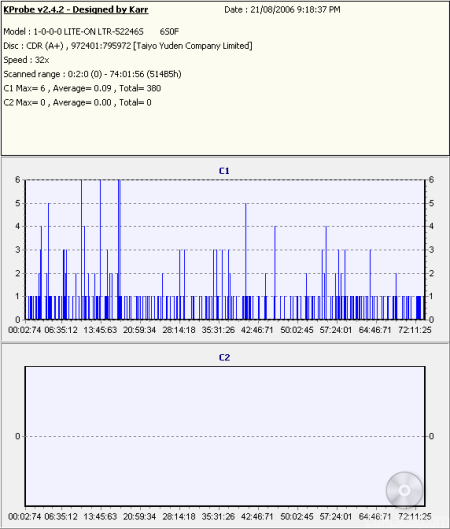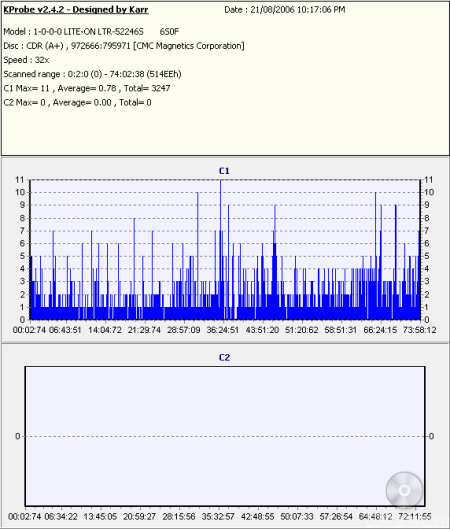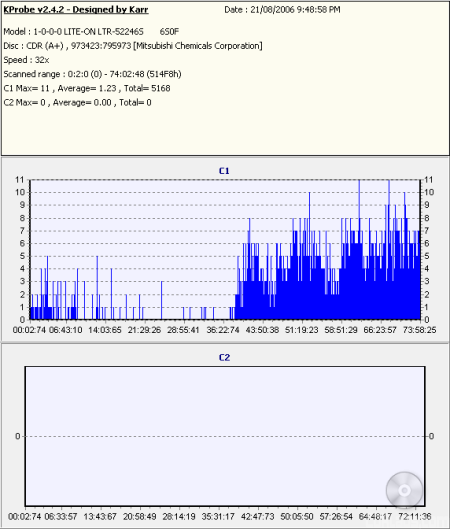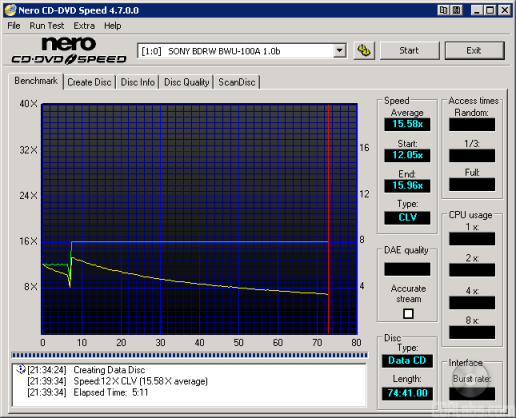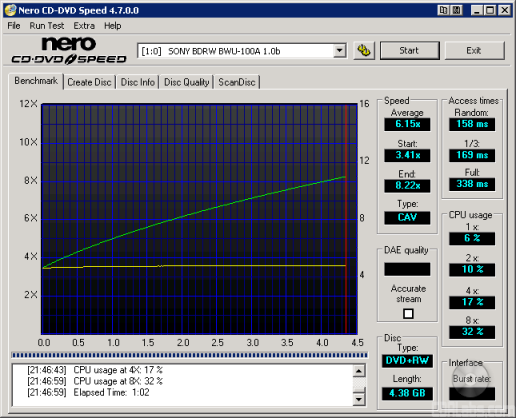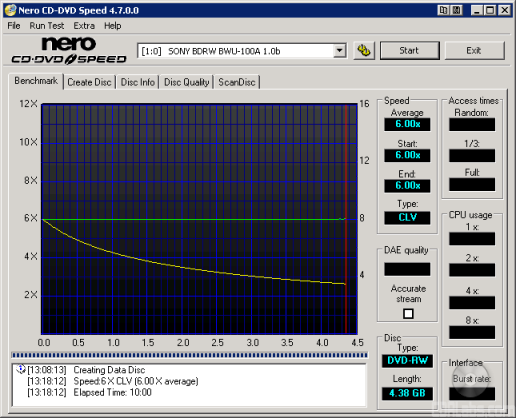
Model: Sony BWU-100A Blu-ray Disc Writer
Manufacturer: Sony Electronics
Provided By: Sony America
Rivalries are a fact of life in the tech industry. Over the years, we've seen some bitter battles between companies like Intel/AMD and Microsoft/Apple. Lately, the biggest battle is between HD DVD and Blu-ray. These two blue-violet laser disc formats have been battling it out to become the preferred next-generation optical disc standard. While both HD DVD and Blu-ray have their strengths and weaknesses, there is no clear winner yet.

This is just a sample of what Sony's new Blu-ray Disc writer has to offer. Over the next few pages we'll take a look at the BWU-100A's features and then see how it compares to the Blu-ray Disc writers from Pioneer and I-O DATA. Does Sony's Blu-ray Disc writer have what it takes? Keep reading as we find out.
What's in the box?:
- Sony BWU-100A Blu-ray Disc Writer
- Software Disc for BD v7.00W
- Operating Instructions
- HDV to Blu-ray Direct Recording Guide
- Mounting Screws
- Warranty Information
Physical Features:
The drive Sony sent us for this review was manufactured in September of 2006 and had firmware version 1.0b. For this review we used firmware versions 1.0b and 1.0c.

The BWU-100A is one of the better looking drives we've had in the 'Labs. More subdued than Sony's previous DVD writers, it sports a sophisticated look thanks in part to its black bezel and silver colored tray. The BWU-100A also has its share of logos. Along with the large "Sony" and "Blu-ray Disc" logos, you can see a few showing off its support for Ultra Speed CD-RW media and theDVD+ReWritable and DVD Multi specifications.

Below the tray you can see the BWU-100A's single LED. Off by default, this LED lights up a bright blue whenever the drive is reading or writing.
The rear of the BWU-100A is pretty straightforward. By looking at the picture below you can see its IDE interface, power connector and audio output connectors.
Starting from the left of the IDE connection you'll see the jumper switch for master, slave and cable select. Next to the jumper block is the analog audio connector. The connector on the far left is the digital audio output.
Technical Specs:
The specs below have been taken from Sony's website and the manual that came with the drive.
| Sony BWU-100A Blu-ray Disc Writer | |
| CD Write Speeds | 24x, 16x (Z-CLV) 12x, 8x (CLV) |
| CD Rewrite Speeds | 16x (Z-CLV) 12x, 8x, 4x (CLV) |
| DVD+R Write Speeds | 8x (Z-CLV) 4x, 2.4x (CLV) |
| DVD+RW Write Speeds | 8x (Z-CLV) 6x, 4x, 2.4x (CLV) |
| DVD-R Write Speeds | 8x (Z-CLV) 4x, 2x (CLV) |
| DVD-RW Write Speeds | 6x, 4x, 2x (CLV) |
| DVD+R DL Write Speeds | 4x, 2.4x (CLV) |
| DVD-R DL Write Speeds | 4x, 2x (CLV) |
| CD Read Speeds | 32x Max (CD-ROM/CD-R) 24x Max (CD-RW) |
| DAE Speeds | 24x Max |
| DVD Read Speeds | 8x Max (DVD-ROM) 8x Max (DVD±R) 8x Max (DVD±RW) 8x Max (DVD±R DL) 5x (DVD-RAM) |
| Buffer Size | 8 MB (BD) 2 MB (CD and DVD) |
| Access Times |
160 ms (CD) 170 ms (DVD-ROM) 210 ms (BD-ROM) |
| CD Formats | CD-DA CD-ROM CD-ROM XA CD-Extra Video CD Photo CD Multi-session CD-Text CD-R CD-RW |
| DVD Formats | DVD-ROM DVD-Video DVD+R/RW DVD-R/RW DVD+R DL DVD-R DL |
| BD Formats | BD-ROM BD-R/RE BD-R/RE DL BDAV |
More Features:
By looking at the picture below, you can see that Sony's new Blu-ray Disc writer is identified as a "SONY BDRW BWU-100A."
The Nero screenshot also shows that the BWU-100A has a maximum CD writing speed of 32x and a 2048KB buffer. This buffer is also backed up by Sony's Power-Burn buffer underrun protection. According to Nero, the BWU-100A can write CD-Text and overburn. When testing the drive's capacity, it had no problems overburning up to 99 minutes with our CompUSA media.
Using Alex Noe's Weak Sector Utility we were able to determine that the BWU-100A is a "two sheep" burner. This means that Sony's new drive is capable of backing up titles protected by SafeDisc 2, including version 2.51.
Here is a screen shot from Nero's InfoTool. This program queries the drive to see what its reading and writing capabilities are. InfoTool had no problems detecting the BWU-100A's maximum reading and writing speeds, recording modes, buffer underrun protection and 2MB buffer.
InfoTool also shows that the BWU-100A is an RPC-2 DVD drive. This means that the drive's region is stored in the firmware. The drive's region can be changed five times and after that it cannot be changed anymore. Unfortunately, a patched RPC-1 firmware is not yet available for this drive.
While InfoTool gives us a quick glance at the BWU-100A's features, DVDINFOpro provides a little more information on some of the drive's reading and writing capabilities. By looking at the screenshot above you can see that Sony's new drive can read and write to most BD and DVD formats.
Sony's new drive also supports a feature called "bitsetting." By default, the BWU-100A automatically sets the book type for DVD+R and DVD+R DL discs to "DVD-ROM". For whatever reason though, the drive does not let you set the book type of DVD+RW discs.
For the BWU-100A's software bundle, Sony has turned to CyberLink. The CD that comes with the drive contains the CyberLink BD Solution suite which includes PowerProducer, PowerDirector, Power2Go, PowerBackup, Medi@Show, InstantBurn, LabelPrint and PowerDVD BD.
CyberLink PowerProducer 3 BD Edition - With CyberLink's PowerProducer you can create your own movie discs quickly and easily. Right from the start, this wizard based software gives you a number of options to select from. From here you can choose to produce a new movie disc, edit an existing one or record video directly to CD, DVD or BD.
PowerProducer lets you create a number of different movie discs. Looking at the menu below, you can choose to create a CD, DVD, or BD. The software also supports various disc capacities and formats including DVD-VR, DVD+VR and BDAV.
While you can capture your own video, PowerProducer will also let you add any MPEG-1, MPEG-2, WMV or DivX video clip to your project. Once you have them imported, you can use the built in editor to trim, merge or split your video clips or add special effects. PowerProducer also allows you to set chapters within the video content and add your own custom menus, backgrounds, fonts and titles.
CyberLink PowerDirector 5 SE-Plus - The BWU-100A also comes with CyberLink's video editing software, PowerDirector. To create your own custom movies, simply drag and drop video footage onto the editing timeline and then add scene transitions, background music, or title effects.
You can also use PowerDirector's "magic" editing tools to clean up video clips and images, condense long video segments and apply pre-designed style templates. When you're done editing your video, you have the option to write it back to DV tape, save it to your hard drive, create a streaming file or burn it to disc using PowerProducer.
CyberLink Power2Go 5 - Power2Go is the main disc burning program included with the BWU-100A. With this software, users can create various types of CD's, DVD's and BD's or make backups of existing discs. Power2Go also offers enhanced security features, allowing you to password protect and encrypt your data discs.
CyberLink PowerBackup 2.5 - If you're looking for a quick and easy way to backup your data, PowerBackup is the answer. Depending on your needs, PowerBackup can do full, differential, and incremental backups as well as fast stream-to-disc archiving.
Backup jobs can be scheduled to run at regular intervals so the data is always protected. PowerBackup also offers more advanced features like file filtering, compression and password protection.
CyberLink Medi@Show 3 - With Medi@Show, you can create, show and share multimedia presentations. Simply drag and drop images, video, audio clips or even PowerPoint files into your presentation and then use the storyboard to rearrange the clips into the order you want. When you're done you can add special effects to your presentation and then save it as an executable file, a screen saver or make it ready for internet publication.CyberLink InstantBurn 5 - InstantBurn is CyberLink's packet writing software. Like Roxio's Drag-to-Disc or Nero's InCD, it lets a person to use their CD, DVD or BD writer as if it was another hard drive or a huge floppy disk.
CyberLink LabelPrint 2 - CyberLink LabelPrint is an intuitive application that lets you design and print stylish CD/DVD labels in four easy steps. Just select your template type, disc information, text layout, background image, and print destination.
CyberLink PowerDVD 6.6 BD - CyberLink's PowerDVD is one of the more popular software DVD players on the market right now. Along with support for Blu-ray Discs, it can be used to play back CD's and DVD's as well as other multimedia formats including DivX.
The version of PowerDVD bundled with the BWU-100A cannot play back commercial Blu-ray Discs protected by AACS. If you want to do this, you will need to upgrade the software first. This upgrade is available for free and can be downloaded from Sony's website.
When it comes to features, the Sony BWU-100A has all of its bases covered. The drive can read and write to single and dual layer BD media at 2x and is backwards compatible with all major CD and DVD formats, including DVD-RAM. The BWU-100A also includes features like an 8MB buffer, Power-Burn buffer underrun protection and a great software bundle from CyberLink. Unfortunately, it lacks bitsetting support for DVD+RW media. Even then, the Sony BWU-100A scores a solid 8 out of 10 for its features.
Installing Sony's new Blu-ray Disc writer took only a few minutes. After taking the drive out of the box, I left the jumper set to master and installed it on the secondary IDE chain by connecting the IDE cable and power connector. When I turned on the computer the BIOS detected it as a drive supporting UDMA 66. After making sure that the DMA was enabled in the Device Manager, I was ready to start installing the software.
Software Installation:
As I mentioned earlier, the BWU-100A comes with a CD full of software from CyberLink. If you have autorun enabled on your computer, the menu shown below will appear when you insert the disc. From here you can choose to install the software or visit Sony's user support web page.
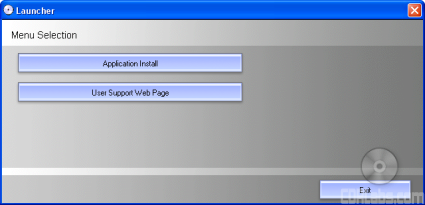
Installing the CyberLink BD Solution suite is pretty straightforward. After selecting your preferred language and entering the serial number, you'll be presented with a list of components to choose from. Simply select the components you want and click next a few times. Once the files are copied over, you can start burning your own discs.
Documentation:
The documentation that comes with the BWU-100A is a bit different than what we're used to seeing from Sony. Instead of spreading the information out between a number of small guides, Sony has put everything into one large manual. It starts out by getting the user familiarized with their new Blu-ray Disc writer. The first section goes over the drive's package contents, features and system requirements. Sony has also provided some pretty good diagrams showing all of the different buttons and connectors located on the front and back of the drive. Everything is labeled clearly and the functions of each are explained very well.
From here, the manual jumps right into the physical installation of the BWU-100A. The instructions take the user step by step through the entire installation process and cover all the basics including how to set the jumpers, install the drive into an empty drive bay and hook up the cables. If you're not sure whether the drive should be set up as a master or slave, it also has a few example configurations along with their corresponding jumper settings.
The manual finishes up by going over the basic operation of the BWU-100A. Along with some brief information on how to install and use the bundled software, this section covers a number of topics including compatible discs and region codes. Last but not least, Sony has provided a comprehensive list of specifications for the BWU-100A. If you need additional help, Sony's support website has a number of resources includingFAQ's, guides and software updates.
Like the other Sony drives we've reviewed, the BWU-100A was very easy to install. Even though Blu-ray is a new technology, there were no problems getting the drive or the software installed and working correctly. For those that might need a little help, the documentation Sony has provided is quite good and contains a lot of useful information. With this in mind, the BWU-100A scores a 9 out of 10 for the installation portion of this review.
While CPU, memory, OS and other variables don't often make a huge difference, there are some nonetheless. We have a computer that is used only for testing hardware. We do this so all tests can be compared reliably.
Test System:
| CPU: | AMD Athlon 64 3200+ 2.0GHz | |
| Motherboard: | ASUS K8V SE Deluxe with BIOS 1003 | |
| Memory: | 2 x 256MB Kingston PC3200 | |
| Video Card: | XFX NVIDIA GeForce FX5200 - ForceWare v91.31 | |
| Hard Drive: | Hitachi Deskstar 7K80 80GB SATA 7200RPM | |
| Operating System: | Windows XP SP2 - VIA Hyperion Pro v5.04 |
For Blu-ray Disc writers, the performance tests are normally broken down into six sections: CD read, CD write, DVD read, DVD write, BD read and BD write. Each benchmark test has been run three times. The score given is an average of the three. DMA has been enabled in device manager for all IDE devices supporting it.
CD Read Tests: For the read performance section of the CD-ROM benchmarks, CD WinBench 99 v3.0 and CD Speed v4.70 are used to test read speeds, seek times and CPU usage. For DAE testing, CD Speed is used to give an overall speed rating.
CD Write Tests: To test the write speeds, Nero Burning Rom is used to write 650MB and 700MB to our test media. Times are recorded. To test rewrite scores, Nero is used again to time how long it takes to write 400MB of random files and directories. Then Sonic's DLA is used to test packet writing speeds. The same files are copied and pasted in Windows Explorer and timed.
DVD Read Tests: For the read performance section of the DVD benchmarks CD Speed v4.70 is used to test read speeds, seek times, and CPU usage.
DVD Write Tests: To test the DVD write speeds, Nero Burning Rom is used to write a 4.38GB image to our test media. Times are recorded. Then Sonic's DLA is used to test packet writing speeds. For this, 4GB of random files and directories are copied and pasted in Windows Explorer and timed.
BD Read Tests: For the read performance section of the BD benchmarks, CD Speed v4.70 is used to test read speeds, seek times, and CPU usage.
BD Write Tests: To test the BD write speeds, CD Speed's "Create Data Disc" feature is used to burn an entire BD-R/RE disc. Times are recorded.
CD Winbench 99 Scores:
| Sony BWU-100A |
I-O DATA BRD-AM2B/U |
|
| CD Winbench 99 | 1465 KB/sec | 1484 KB/sec |
| Transfer Rate: Inside | 2410 KB/sec | 2410 KB/sec |
| Transfer Rate: Outside | 4770 KB/sec | 4770 KB/sec |
| Random Access Time | 132ms | 131ms |
| CPU Utilization | 0.41% | 0.32% |
The CD Winbench test is as close as we can get to testing every day usage. It fires off eight different applications using scripts. This tries to mimic the activities of a person loading these programs onto their own computer.
Sony's Blu-ray Disc writer performed pretty well in our CD Winbench tests. In the transfer speed tests, the drive started reading at about 16.1x on the inside of the CD and was able to reach 31.8x on the outside of the disc. While this helped give the BWU-100A a respectable overall score, its access time and CPU usage was not as low as some of the other drives we've looked at.
CD Speed v4.70 - Pressed CD:
For this test I used a pressed CD containing one Mode 1 data track. The disc is 74:38 in size and is full of data and directories.
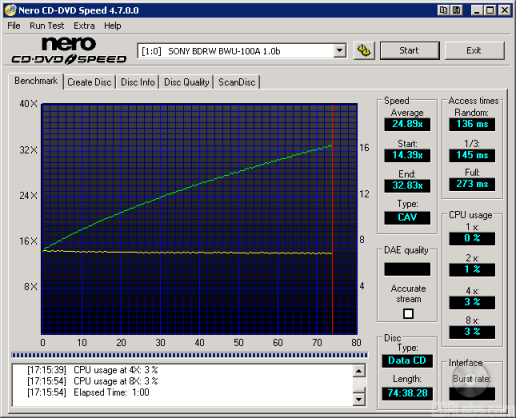
| Sony BWU-100A |
I-O DATA BRD-AM2B/U |
|
| Transfer Speed Average: Start: End: |
24.89x 14.39x 32.83x |
24.85x 14.32x 32.85x |
| Seek Times Random: 1/3: Full: |
137ms 145ms 273ms |
134ms 144ms 274ms |
| CPU Usage 1x: 2x: 4x: 8x: |
0% 1% 3% 3% |
0% 1% 3% 4% |
Sony's new drive performed a little better in our CD Speed tests. The BWU-100A started reading at 14.39x and reached a maximum transfer speed of 32.83x. Unfortunately, its seek times were a little higher than we'd like to see.
CD Speed v4.70 - CD-R Media:
For this test I made a copy of our pressed test CD. I used 12x rated Memorex Gold 74 minute media for the tests.
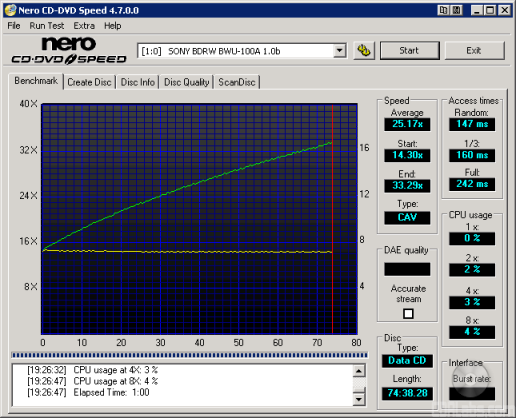
| Sony BWU-100A |
I-O DATA BRD-AM2B/U |
|
| Transfer Speed Average: Start: End: |
25.17x 14.30x 33.29x |
24.75x 14.34x 32.67x |
| Seek Times Random: 1/3: Full: |
148ms 160ms 242ms |
145ms 158ms 237ms |
| CPU Usage 1x: 2x: 4x: 8x: |
0% 2% 3% 4% |
0% 2% 3% 4% |
The BWU-100A was a little faster when reading CD-R media. Thanks to this small speed boost, the drive was able to reach a maximum transfer speed of more than 33x.
Sony's new Blu-ray Disc drive had no problems recognizing our 99 minute CompUSA media. It read our test disc from start to finish, reaching a maximum transfer speed of 35.64x.
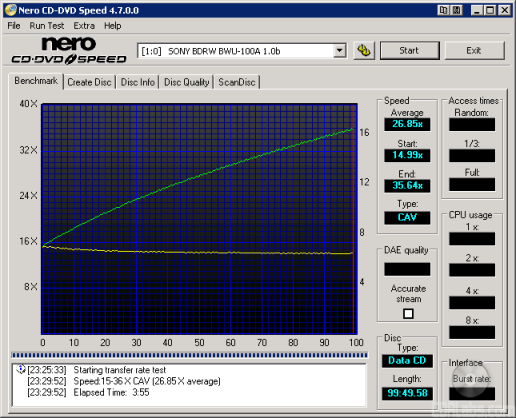
CD Speed v4.70 - CD-RW Media:
For this test I made a copy of a pressed test CD. I used some PNY 80 minute CD-RW media for the tests.
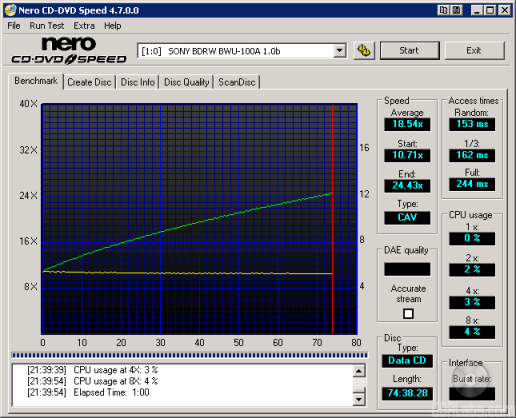
| Sony BWU-100A |
I-O DATA BRD-AM2B/U |
|
| Transfer Speed Average: Start: End: |
18.54x 10.71x 24.43x |
18.61x 10.74x 24.57x |
| Seek Times Random: 1/3: Full: |
152ms 162ms 244ms |
130ms 141ms 221ms |
| CPU Usage 1x: 2x: 4x: 8x: |
0% 2% 3% 4% |
1% 2% 3% 4% |
While the BWU-100A can read pressed and CD-R media at 32x, its CD-RW read speeds are limited to only 24x. As you can see, the drive had no problems reaching this speed in our tests.
CD DAE and CD Speed v4.70 - Pressed CD:
For this test I used Pure Funk. The CD is almost exactly 74 minutes. This helps to squeeze the maximum performance out of the CD.

Exact Audio Copy can tell us a lot about a drive's capabilities. You can see from the screen shot that while the Sony BWU-100A supports accurate stream and has the ability to retrieve C2 error information from the CD, it does not cache audio data.
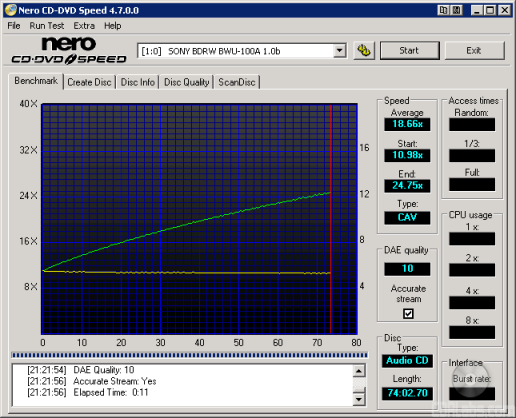
| CD Speed | Sony BWU-100A |
I-O DATA BRD-AM2B/U |
| Average: Start: End: DAE Quality: Accurate Stream: |
18.66x 10.98x 24.75x 10 Yes |
18.66x 10.96x 24.75x 10 Yes |
While the BWU-100A had no problems reaching its rated speed in our DAE tests, it wasn't as fast as I would have liked. Looking at the scores above, you can see that it reached a maximum DAE speed of only 24x.
CD DAE and CD Speed v4.70 - CD-R Media:
For this test I used a copy of the Pure Funk CD. It's burned onto the same Memorex Gold 74 minute media I used in the CD Speed tests.
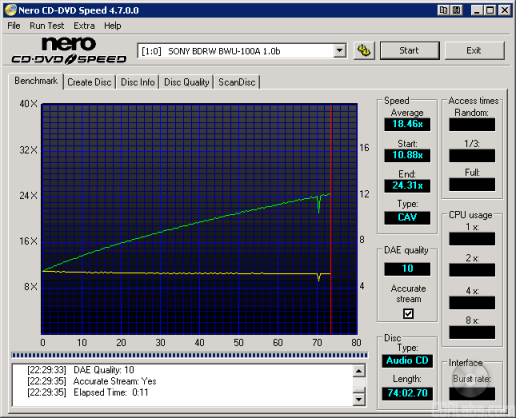
| CD Speed | Sony BWU-100A |
I-O DATA BRD-AM2B/U |
| Average: Start: End: DAE Quality: Accurate Stream: |
18.46x 10.88x 24.31x 10 Yes |
18.48x 10.90x 24.31x 10 Yes |
While the BWU-100A was a little slower when ripping audio CD-R discs, it had no problems reaching a maximum DAE speed of 24x in our tests. So how did it do in CD Speed's advanced DAE tests? Take a look below.

Unfortunately, Sony's new Blu-ray Disc writer didn't do as well as I would have liked in CD Speed's advanced DAE tests. The drive not only failed to pass all of the on the fly copying tests, it created a small number of errors. While the BWU-100A's error correction would probably take care of them, this is something that you really don't want to see. In the advanced features tests, the drive was able to read the CD-Text, subchannel data and lead in but failed to read the lead out section of the CD.
To see how well Sony's Blu-ray Disc writer can read scratched and dirty discs, I used CD Speed's ScanDisc utility to see how many sectors were damaged or unreadable. This is a very rough, but good way to test the drive's error correcting abilities.

CD Speed - ScanDisc
The BWU-100A did surprisingly well here. By looking at the screenshot, you can see that the drive considered only 53.2% of the CD to be "damaged". On top of that, none of the sectors on the disc were unreadable.
You can also get an idea of how well the drive can read scratched and dirty discs by using CD DAE. CD DAE will extract the audio tracks twice and then compare them. From this information we can see what the drive's average speed was and how many errors it generated.
| CD DAE | Avg. Speed | Errors | % of Disc |
| Sony BWU-100A | 17.6x | 66749492 | 8.51% |
| I-O DATA BRD-AM2B/U | 1.6x | 2446960 | 0.31% |
Sony's new drive gave some mixed results in this test. While the scratches on the disc didn't slow the drive down very much, the number of errors was a little higher than what we'd like to see.
CD Write and ReWrite Tests - Nero Burning Rom 6.6.1.4 andDLA 5.20:
For this test I randomly generated 650MB and 700MB of files and directories to test the time it takes the drive to write and close a CD. All of the files are between 1MB and 25MB in size and no more than 10 directories deep.
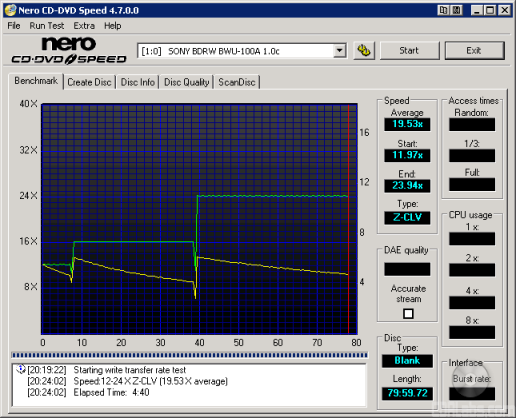
The BWU-100A uses Z-CLV, or Zone CLV, to reach its maximum writing speed. By looking at the screenshot above, you can see that it uses a total of three "zones" to reach 24x. The drive starts writing at 12x and jumps to 16x at about the 8 minute mark.The BWU-100A writes at this speed until about the 39 minute mark. When it reaches this point, its writing speed increases to 24x and stays there until the end of the session.
To test the drive's writing times, I wrote our test data to some Taiyo Yuden manufactured Fuji media rated at 48x. The results are below.
| Size in MB | Size in Time | Sony BWU-100A |
I-O DATA BRD-AM2B/U |
| 701MB | 79:44:21 | 4:45 | 4:46 |
To test the drive's writing quality I used Lite-On IT's KProbe2. Written by Karr Wang, this utility can be used to test the number of C1 and C2 errors on a disc. For these tests I used a Lite-On LTR-52246S (firmware 6S0F) and read the discs at 32x.
The BWU-100A's writing quality was very good. By looking at the KProbe screenshots, you can see that the discs burned by the drive had a low number of C1 errors. More importantly, there were no C2 errors at all.
For the rewriting tests I created 400MB of files on the hard drive and wrote them in DAO mode using Nero. To test the packet writing speeds I copied and pasted the same files off the hard drive onto a CD-RW disc using DLA from Sonic. Verbatim's 24x Ultra Speed CD-RW media was used for these tests.
The BWU-100A also uses Z-CLV when rewriting at 16x. The drive starts rewriting at 12x, and then jumps up to 16x at the 7 minute mark.
| Software | Sony BWU-100A |
I-O DATA BRD-AM2B/U |
| Nero | 3:25 | 3:24 |
| DLA Write | 3:34 | 3:35 |
| DLA Read | 2:22 | 2:28 |
Sony's new DVD writer did fairly well in our rewriting tests. The drive took 3:25 to write 400MB with Nero and 3:34 to do the same with DLA.
| Sony BWU-100A |
I-O DATA BRD-AM2B/U |
|
| Quick Erase | 19 seconds | 18 seconds |
| Full Erase | 5:13 | 5:11 |
The BWU-100A also erases at 16x. At this speed, it took the drive 19 seconds to do a quick erase and 5:13 to fully erase the disc.
Nero CD Speed v4.70 - DVD-ROM:
A little editorial note here. Like a CD-ROM, you will get different benchmark results depending on what kind of discs you are using. You are probably going to get varying results from a full data disc to a single layer movie disc. You're also going to get different results for single and dual layer discs.
The DVD Speed website recommends using a single layer DVD-ROM disc with a capacity of at least 4GB. If you use a dual layer disc you probably won't get the best results because most DVD-ROM drives slow down to read them. Some even slow down to read single layer DVD-Video discs. To make a long story short, I am using a 4.37GB single layer, single sided disc for this test.

| Sony BWU-100A |
I-O DATA BRD-AM2B/U |
Pioneer BDR-101A |
|
| Transfer Speed Average: Start: End: |
6.15x 3.41x 8.22x |
6.15x 3.41x 8.23x |
6.22x 3.44x 8.32x |
| Seek Times Random: 1/3: Full: |
140ms 156ms 296ms |
133ms 147ms 285ms |
136ms 169ms 313ms |
| CPU Usage 1x: 2x: 4x: 8x: |
6% 9% 17% 32% |
6% 10% 17% 32% |
6% 10% 18% 33% |
The BWU-100A performed as expected when reading single layer DVD-ROM's. In our tests it started reading at 3.41x and reached a maximum transfer speed of about 8.22x.
Nero CD Speed v4.70 - DVD-R and DVD-RW:
First, we'll look at the drive's DVD-R and DVD-RW reading performance. For this I made copies of our DVD-ROM test disk using some general use 4x DVD-R and 2x DVD-RW media from Verbatim and then ran our usual DVD read tests with CD Speed. The results are below.

Verbatim DVD-R
| Sony BWU-100A |
I-O DATA BRD-AM2B/U |
Pioneer BDR-101A |
|
| Transfer Speed Average: Start: End: |
6.15x 3.40x 8.22x |
6.15x 3.41x 8.22x |
6.24x 3.46x 8.33x |
| Seek Times Random: 1/3: Full: |
152ms 166ms 305ms |
137ms 154ms 290ms |
147ms 178ms 328ms |
| CPU Usage 1x: 2x: 4x: 8x: |
6% 9% 17% 31% |
6% 9% 17% 32% |
6% 11% 19% 35% |
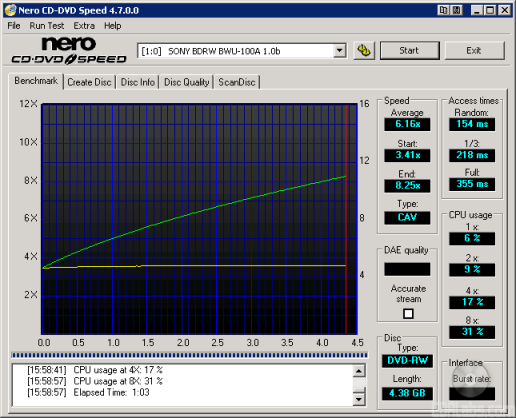
Verbatim DVD-RW
| Sony BWU-100A |
I-O DATA BRD-AM2B/U |
Pioneer BDR-101A |
|
| Transfer Speed Average: Start: End: |
6.16x 3.41x 8.25x |
6.16x 3.40x 8.24x |
4.72x 2.61x 6.31x |
| Seek Times Random: 1/3: Full: |
153ms 219ms 355ms |
138ms 201ms 340ms |
148ms 183ms 331ms |
| CPU Usage 1x: 2x: 4x: 8x: |
6% 9% 17% 31% |
6% 9% 17% 31% |
6% 11% 19% n/a |
Verbatim DVD-R DL
| Sony BWU-100A |
I-O DATA BRD-AM2B/U |
Pioneer BDR-101A |
|
| Transfer Speed Average: Start: End: |
6.17x 3.43x 8.22x |
6.17x 3.43x 8.22x |
4.72x 2.63x 6.28x |
| Seek Times Random: 1/3: Full: |
158ms 172ms 310ms |
140ms 152ms 284ms |
156ms 182ms 336ms |
| CPU Usage 1x: 2x: |
4% 8% |
4% 8% |
6% 11% |
Sony's new drive had no problems reading DVD-R, DVD-RW and DVD-R DL media. In all three cases, the BWU-100A reached a maximum transfer speed of about 8.2x.

Maxell 5x DVD-RAM
| Sony BWU-100A |
I-O DATA BRD-AM2B/U |
|
| Transfer Speed Average: Start: End: |
4.99x 4.97x 5.00x |
4.98x 4.97x 5.00x |
| Seek Times Random: 1/3: Full: |
354ms 529ms 1126ms |
338ms 509ms 1107ms |
| CPU Usage 1x: 2x: 4x: |
13% 26% 22% |
11% 37% 22% |
The BWU-100A has a maximum transfer speed of 5x when reading DVD-RAM discs. By looking at the screenshot, you can see that it reads at this speed from start to finish. Unfortunately, like the drive from I-O DATA, its seek times were also very high.
Nero CD Speed v4.70 - DVD+R and DVD+RW:
Next we'll look at the drive's DVD+R and DVD+RW reading performance. For this I made a copy of our DVD-ROM test disk using some 4x DVD+R and 2.4x DVD+RW media from Verbatim. I then ran our usual DVD read tests with CD Speed. The results are below.

Verbatim DVD+R
| Sony BWU-100A |
I-O DATA BRD-AM2B/U |
Pioneer BDR-101A |
|
| Transfer Speed Average: Start: End: |
6.15x 3.41x 8.22x |
6.15x 3.40x 8.22x |
6.23x 3.46x 8.34x |
| Seek Times Random: 1/3: Full: |
156ms 169ms 313ms |
141ms 155ms 294ms |
147ms 178ms 331ms |
| CPU Usage 1x: 2x: 4x: 8x: |
6% 10% 17% 32% |
6% 9% 17% 32% |
6% 10% 18% 33% |
Verbatim DVD+RW
| Sony BWU-100A |
I-O DATA BRD-AM2B/U |
Pioneer BDR-101A |
|
| Transfer Speed Average: Start: End: |
6.15x 3.41x 8.22x |
6.15x 3.41x 8.22x |
4.72x 2.60x 6.30x |
| Seek Times Random: 1/3: Full: |
156ms 170ms 338ms |
141ms 155ms 320ms |
153ms 186ms 339ms |
| CPU Usage 1x: 2x: 4x: 8x: |
6% 10% 17% 32% |
6% 10% 17% 32% |
6% 10% 18% n/a |
Verbatim DVD+R DL
| Sony BWU-100A |
I-O DATA BRD-AM2B/U |
Pioneer BDR-101A |
|
| Transfer Speed Average: Start: End: |
6.18x 3.44x 8.24x |
6.18x 3.44x 8.24x |
4.73x 2.63x 6.31x |
| Seek Times Random: 1/3: Full: |
159ms 170ms 310ms |
148ms 156ms 299ms |
159ms 186ms 337ms |
| CPU Usage 1x: 2x: |
5% 9% |
5% 8% |
6% 10% |
The BWU-100A's performance with DVD+R, DVD+RW and DVD+R DL media was very similar to what we saw with DVD-R, DVD-RW and DVD-R DL media.Once again, the drive reached a maximum transfer speed of about 8.2x.
Nero CD Speed v4.70 - DVD-Video:
For these tests I am using the US version of Transformers: The Movie on DVD. The disc is over 4GB and single sided.
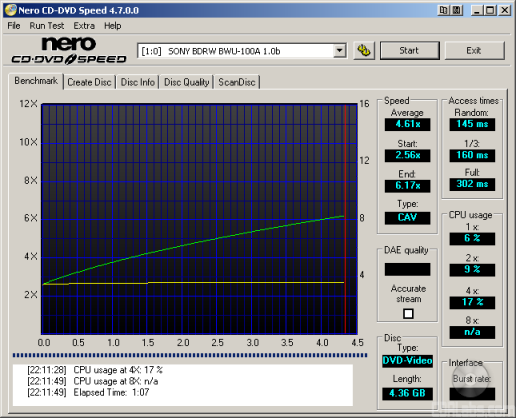
| Sony BWU-100A |
I-O DATA BRD-AM2B/U |
Pioneer BDR-101A |
|
| Transfer Speed Average: Start: End: |
4.61x 2.56x 6.17x |
4.62x 2.56x 6.18x |
3.88x 2.15x 5.20x |
| Seek Times Random: 1/3: Full: |
145ms 162ms 302ms |
131ms 145ms 284ms |
137ms 167ms 314ms |
| CPU Usage 1x: 2x: 4x: |
6% 9% 17% |
6% 10% 17% |
6% 12% 26% |
The BWU-100A wasn't as fast when reading single layer DVD-Videos. In our tests, it reached a maximum speed of only 6x when reading both single and dual layer discs.
To see how well Sony's new drive worked as a DVD player, I watched a few scenes from Transformers: The Movie and Star Wars: The Phantom Menace using WinDVD 5 and PowerDVD 5. The BWU-100A had no problems playing back these movies with either program and was fairly quiet.
DVD Write and ReWrite Tests - Nero Burning Rom 6.6.1.4 andDLA 5.20:
To test the DVD writing performance of Sony's new drive I used Verbatim 16x DVD+R, 16x DVD-R, 4x DVD-RW and 4x DVD+RW media. To get the writing times, a 4.38GB image was burned to our test discs using Nero.
When writing to DVD+R and DVD-R media at 8x, the BWU-100A uses Z-CLV, or Zone CLV. By looking at the screenshot above, you can see that the drive starts writing at 4x. When it reaches the 1.6GB mark, the writing speed increases to 8x and stays there until the very end of the session.
The BWU-100A also features 8x DVD+RW and 6x DVD-RW writing speeds. While the drive uses CLV when writing to DVD-RW media, it uses Z-CLV to reach its maximum DVD+RW writing speed.
| Sony BWU-100A |
I-O DATA BRD-AM2B/U |
Pioneer BDR-101A |
|
| DVD+R | 9:29 | 9:23 | 10:35 |
| DVD-R | 9:16 | 9:16 | 10:30 |
| DVD+RW | 8:24 | 8:26 | 14:13 |
| DVD-RW | 10:00 | 9:59 | 14:52 |
While the BWU-100A wasn't nearly as fast as some of the DVD writers we've looked at recently, it performed as expected with both DVD±R and DVD±RW media.
To check the media compatibility of the BWU-100A, I ran a few tests using some of the media available in my area. The media types, along with the average time it took the drive to write our 4.38GB image, are listed below.
| Manufacturer ID | Max Write Speed |
Average Write Time |
|
| Memorex 16x DVD+R | RICOHJPN R03 | 8x | 9:28 |
| RiDATA 16x DVD+R | RITEKR04 | 8x | 9:23 |
| Taiyo Yuden 16x DVD+R | YUDEN000T03 | 8x | 9:29 |
| Verbatim 16x DVD+R | MCC-004 | 8x | 9:28 |
| Memorex 16x DVD-R | CMC MAG.AM3 | 8x | 9:18 |
| RiDATA 16x DVD-R | RITEKF1 | 8x | 9:16 |
| Taiyo Yuden 16x DVD-R | TYG03 | 8x | 9:17 |
| Verbatim 16x DVD-R | MCC 03RG20 | 8x | 9:16 |
So what about writing quality? Testing a drive's DVD writing quality isn't easy. Until now, there were very few options, unless you wanted to shell out thousands of dollars for a certified test machine. Thanks to KProbe, we can test a disc's PI (Parity Inner) and PIF (Parity Inner Fail) rates.For these tests I used a Lite-On SOHW-1673S and read the discs at 4x with the PI and PIF ECC sums set to 8 and 1 respectively. For comparison, I also tested the discs on a BenQ DW1640. When combined with Nero CD Speed, the DW1640 is able to report PI Errors, PI Failures, Parity Outer Failures and even jitter levels. For this test, the discs are read at 8x with both the PI and PIF ECC sums set to 8.
So what are "good" results supposed to look like? With KProbe, the PI errors should not exceed 280 and the number of PIF errors should stay below 4. When testing with CD Speed, the number of PI errors should stay below 280 as well. However, because it scans with an ECC sum of 8, a higher number of PIF errors is acceptable, as long as they do not exceed 32. Since POF errors are uncorrectable, we really don't want to see any of them at all.
I also put these discs through a "stress test" by reading them back at 16x with the DW1640. By reading these discs back at this speed, we can see if there are any readability issues caused by the number of errors or high levels of jitter.
|
|
||||||||||||||||||||||||||||||||||||||||||||||||
|
|
||||||||||||||||||||||||||||||||||||||||||||||||
The BWU-100A's writing quality was pretty good with most of the DVD+R media we tested. Aside from a few small spikes, the PI/PIF rates stayed within acceptable limits.
|
|
||||||||||||||||||||||||||||||||||||||||||||||||
|
|
||||||||||||||||||||||||||||||||||||||||||||||||
Lastly, here are some results from our DVD-R test media. While the writing quality varied from one manufacturer to another, the results were fairly good for the most part.
| Sony BWU-100A |
I-O DATA BRD-AM2B/U |
Pioneer BDR-101A |
|
| DVD+RW Quick | 3 seconds | 3 seconds | 11 seconds |
| DVD+RW Full | 8:14 | 8:17 | 14:17 |
| DVD-RW Quick | 22 seconds | 21 seconds | 51 seconds |
| DVD-RW Full | 9:51 | 10:35 | 14:56 |
To test the BWU-100A's packet writing performance I used DLA 5.20. Verbatim 8x DVD+RW, Verbatim 6x DVD-RW and Maxell 5x DVD-RAM media were used once again.
| Sony BWU-100A |
I-O DATA BRD-AM2B/U |
Pioneer BDR-101A |
|
| DVD+RW Write | 7:32 | 8:30 | failed |
| DVD+RW Read | 9:05 | 8:48 | failed |
| DVD-RW Write | 8:25 | 8:25 | 14:22 |
| DVD-RW Read | 8:33 | 12:45 | 21:40 |
| DVD-RAM Write | 25:41 | 25:38 | n/a |
| DVD-RAM Read | 10:42 | 10:25 | n/a |
The BWU-100A performed pretty well in our packet writing tests. While not the fastest drive we've tested, it turned in some respectable times when reading and writing to DVD±RW and DVD-RAM media.
Double Layer DVD Write Tests - Nero Burning Rom 6.6.1.4:
To test the double layer DVD writing performance of the BWU-100A, I used Verbatim 2.4x DVD+R DL, Verbatim 4x DVD-R DL, Memorex 2.4x DVD+R DL and RiDATA 4x DVD-R DL media. I created about 8GB of random files and directories on my hard drive and then burned them to our test discs with Nero.
Sony's new drive had no problems writing to the Verbatim 2.4x DVD+R DL, Verbatim 4x DVD-R DL and RiDATA 4x DVD-R DL media at 4x. With Memorex's 2.4x DVD+R DL media though, the writing speed was limited to only 2.4x.
| Sony BWU-100A |
I-O DATA BRD-AM2B/U |
Pioneer BDR-101A |
|
| DVD+R DL Write | 27:05 | 27:05 | 43:43 |
| DVD-R DL Read | 26:54 | 27:45 | 54:31 |
With Nero, it took the BWU-100A about 27 minutes to write 8001MB of data. If you do the math, this is a good 16 minutes faster than the drive from Pioneer. So what about writing quality? Take a look below.
|
|
||||||||||||||||||||||||||||||||||||||||||||||||
|
|
||||||||||||||||||||||||||||||||||||||||||||||||
The writing quality was pretty good with Verbatim's DVD+R DL and DVD-R DL media. While higher on the second layer, the PI/PIF rates stayed within acceptable limits and there were no readability problems. Unfortunately, the results weren't nearly as good with Memorex's DVD+R DL and RiDATA's DVD-R DL media. When scanned with the BenQ DW1640, the PI/PIF rates were very high at the layer change, causing some dips in the transfer rate graphs.
Nero CD Speed v4.70 - BD-ROM:
To test the BWU-100A's BD-ROM reading performance, I used the Blu-ray Disc version of The Fifth Element. This single layer disc is about 23GB in size.

| Sony BWU-100A |
I-O DATA BRD-AM2B/U |
Pioneer BDR-101A |
|
| Transfer Speed Average: Start: End: |
2.00x 2.00x 2.00x |
2.00x 2.00x 2.00x |
2.00x 1.99x 2.00x |
| Seek Times Random: 1/3: Full: |
123ms 228ms 407ms |
125ms 208ms 399ms |
56ms 174ms 385ms |
| CPU Usage 1x: 2x: 4x: 8x: |
0% 1% 2% 3% |
0% 1% 1% 3% |
0% 1% 2% 3% |
Sony's new drive has a maximum speed of 2x when reading BD-ROM discs. By looking at the screenshot you can see that the drive starts reading at about 2x and stays there until the end.I should also point out that CD Speed's CPU usage test does not seem to work correctly. The drive cannot read BD media at 8x, let alone 4x, so I'm not sure how it's generating those results.
Unfortunately, I wasn't able to play back the movie on our test computer using the upgraded version of CyberLink's PowerDVD BD software. Every time I tried to play the movie, PowerDVD returned an error stating that the graphics card was not supported. Switching to WinDVD BD yielded much better results. This software had no problems playing back the movie. However, because the computer lacks an HDCP compliant video card, the movie was downsampled to 540p.
Nero CD Speed v4.70 - BD-R and BD-RE:
Next we'll look at the drive's BD-R and BD-RE reading performance. For this I created a few data discs using single layer BD-R and BD-RE media from Memorex and then ran our BD read tests with CD Speed.

Memorex BD-R
| Sony BWU-100A |
I-O DATA BRD-AM2B/U |
Pioneer BDR-101A |
|
| Transfer Speed Average: Start: End: |
2.00x 1.99x 2.00x |
2.00x 1.99x 2.00x |
2.00x 1.99x 2.00x |
| Seek Times Random: 1/3: Full: |
101ms 215ms 390ms |
100ms 204ms 366ms |
71ms 200ms 349ms |
| CPU Usage 1x: 2x: 4x: 8x: |
0% 1% 2% 4% |
0% 1% 2% 3% |
0% 1% 2% 3% |
Memorex BD-RE
| Sony BWU-100A |
I-O DATA BRD-AM2B/U |
Pioneer BDR-101A |
|
| Transfer Speed Average: Start: End: |
2.00x 1.99x 2.00x |
2.00x 2.00x 2.00x |
2.00x 2.00x 2.00x |
| Seek Times Random: 1/3: Full: |
101ms 219ms 391ms |
100ms 203ms 360ms |
70ms 200ms 345ms |
| CPU Usage 1x: 2x: 4x: 8x: |
0% 1% 2% 4% |
0% 1% 2% 3% |
0% 1% 2% 3% |
Sony's new drive had no problems reading Memorex's BD-R and BD-RE media. In both cases, the BWU-100A started reading at 2x and stayed at that speed throughout the entire session.
BD Write and ReWrite Tests - Nero CD Speed v4.70:
To test the BD writing performance of Sony's new drive I used BD-R and BD-RE media from Memorex, Sony, TDK and Verbatim. To get the writing times, CD Speed's "Create Data Disc" feature was used. I also ran the discs through CD Speed's transfer rate test to make sure that the BWU-100A could read them back.
The BWU-100A writes to BD-R and BD-RE at 2x. Looking at the screenshots above, you can see that it writes at this speed from start to finish.
| Manufacturer ID | Average Write Time |
||
| Memorex 25GB BD-RE | MEI T01 | 45:02 | Transfer Rate |
| Sony 25GB BD-R | SONY ES1 | 45:22 | Transfer Rate |
| Sony 50GB BD-R DL | MEI T01 | 90:34 | Transfer Rate |
| Sony 25GB BD-RE | SONY ES1 | 45:01 | Transfer Rate |
| TDK 25GB BD-R | TDKBLDRBA | 45:23 | Transfer Rate |
| TDK 25GB BD-RE | TDKBLDWBA | 45:04 | Transfer Rate |
| Verbatim 25GB BD-R | VERBATIMa | 45:22 | Transfer Rate |
| Verbaim 25GB BD-RE | VERBATIM0 | 45:03 | Transfer Rate |
As you can see, writing to BD-R and BD-RE media isn't a speedy process. In our tests, it took the BWU-100A more than 45 minutes to write an entire 25GB BD-R/RE disc and about 90 minutes to do the same with Sony's new 50GB BD-R DL media.
Performance Revisited:
Sony's new Blu-ray Disc writer performed as expected throughout most of our tests. The BWU-100A worked well with all of the BD media we tried. However, it took a considerable amount of time to read and write an entire disc. Reading and writing to CD's and DVD's wasn't a problem for the drive either. While the BWU-100A won't win any speed contests, it had no problems reaching its rated read speeds and held its own fairly well in our writing tests. With all of these things considered, I give the Sony BWU-100A a 7 out of 10 for its performance.
While many of Sony's Blu-ray products have faced numerous delays and shortages, the launch of their first Blu-ray Disc writer has gone off without a hitch. A true multi format drive, the BWU-100A offers support for both single and dual layer BD media, as well as standard DVD's and CD's. This, combined with a great software bundle from CyberLink, make the BWU-100A an attractive choice for those looking to record high-definition video or back up large amounts of data.
Like most other first generation Blu-ray Disc drives, the BWU-100A can write to BD-R and BD-RE media at 2x. At this speed, it took the drive a little more than 45 minutes to burn an entire single layer, 25GB disc. Not surprisingly, the time taken to record a 50GB BD-R DL disc was roughly double this, clocking in at 90 minutes. Reading Blu-ray media wasn't a speedy process either. With a maximum read speed of 2x, it can take a considerable amount of time to read your data back.
Sony's new drive also has the ability to read and write to all standard DVD formats, including DVD-RAM. In our tests, the BWU-100A had no problems holding its own against the Blu-ray Disc writers from I-O DATA and Pioneer. However, with a maximum DVD±R writing speed of only 8x, it's no match for the current crop of DVD±RW drives. When it came to reading DVD's, the BWU-100Awas able to read single layer data DVD's and most recordable media at 8x but slowed to 6x when reading DVD-Videos.
Reading and writing CD's wasn't a problem for the BWU-100A either. While the drive's seek times were a little higher than I would have liked, it had no problems reading pressed and CD-R media at 32x and CD-RW discs at 24x. As a writer, the BWU-100A performed as expected. With its 24x CD-R and 16x CD-RW writing speeds, the drive won't break any speed records. However, they should be more than enough if you need to write an occasional CD or two.
The BWU-100A also has a good number of features. To make the drive stand out, Sony has given it a very contemporary look as well as a bright blue LED. On the inside, the BWU-100A has an 8MB buffer that is backed up by Sony's Power Burn technology. While the drive only utilizes 2MB of the buffer when writing to CD's and DVD's, this system worked flawlessly in our tests. The BWU-100A also has the ability to set the book type of DVD+R and DVD+R DL media and includes a great software bundle from CyberLink.
Sony's new Blu-ray Disc writer is available now and can be purchased through some of the online vendors listed on Pricegrabber. Prices vary depending on the seller, but the BWU-100A can be picked up for less than $700.
| Sony BWU-100A Blu-ray Disc Writer |
|
| Features: Installation: Performance: |
8 9 7 |
| Overall: | 8 |
Highs:
- Writes to BD-R and BD-RE media at 2x
- Writes to DVD-R and DVD+R media at 8x
- Writes to DVD+RW media at 8x
- Writes to DVD-RW media at 6x
- Writes to DVD+R DL and DVD-R DL media at 4x
- Writes to DVD-R DL media at 2x
- Reads Blu-ray Disc media at 2x
- Reads single layer DVD-ROM's at 8x
- Reads DVD±R, DVD±RW and DVD±R DL media at 8x
- Reads and writes DVD-RAM media at 5x
- Features 24x CD-R and 16x CD-RW writing speeds
- Includes buffer underrun prevention technology
- 8MB buffer (BD only)
- Good CD-R writing quality
- Includes software from CyberLink
- Overburns to 99 minutes
- Nice looking design with bright blue LED
- Automatically sets book type to DVD-ROM for DVD+R and DVD+R DL media
Lows:
- Expensive
- Bundled Blu-ray Disc playback software does not support some video cards
- Questionable writing quality with some DVD±R DL media
- Cannot set the book type of DVD+RW media
- Buffer limited to 2MB when writing CD's and DVD's
